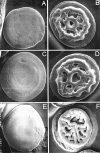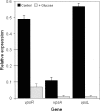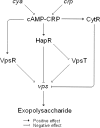The cyclic AMP receptor protein modulates colonial morphology in Vibrio cholerae
- PMID: 17921282
- PMCID: PMC2168207
- DOI: 10.1128/AEM.01564-07
The cyclic AMP receptor protein modulates colonial morphology in Vibrio cholerae
Abstract
Inactivation of the quorum-sensing regulator HapR causes Vibrio cholerae El Tor biotype strain C7258 to adopt a rugose colonial morphology that correlates with enhanced biofilm formation. V. cholerae mutants lacking the cyclic AMP (cAMP) receptor protein (CRP) produce very little HapR, which results in elevated expression of Vibrio exopolysaccharide (vps) genes and biofilm compared to the wild type. However, Deltacrp mutants still exhibited smooth colonial morphology and expressed reduced levels of vps genes compared to isogenic hapR mutants. In this study we demonstrate that deletion of crp and cya (adenylate cyclase) converts a rugose DeltahapR mutant to a smooth one. The smooth DeltahapR Deltacrp and DeltahapR Deltacya double mutants could be converted back to rugose by complementation with crp and cya, respectively. CRP was found to enhance the expression of VpsR, a strong activator of vps expression, but to diminish transcription of VpsT. Ectopic expression of VpsR in smooth DeltahapR Deltacrp and DeltahapR Deltacya double mutants restored rugose colonial morphology. Lowering intracellular cAMP levels in a DeltahapR mutant by the addition of glucose diminished VpsR expression and colonial rugosity. On the basis of our results, we propose a model for the regulatory input of CRP on exopolysaccharide biosynthesis.
Figures





Similar articles
-
The cyclic AMP receptor protein modulates quorum sensing, motility and multiple genes that affect intestinal colonization in Vibrio cholerae.Microbiology (Reading). 2007 Sep;153(Pt 9):2964-2975. doi: 10.1099/mic.0.2007/006668-0. Microbiology (Reading). 2007. PMID: 17768239
-
Interplay between cyclic AMP-cyclic AMP receptor protein and cyclic di-GMP signaling in Vibrio cholerae biofilm formation.J Bacteriol. 2008 Oct;190(20):6646-59. doi: 10.1128/JB.00466-08. Epub 2008 Aug 15. J Bacteriol. 2008. PMID: 18708497 Free PMC article.
-
Regulation of rugosity and biofilm formation in Vibrio cholerae: comparison of VpsT and VpsR regulons and epistasis analysis of vpsT, vpsR, and hapR.J Bacteriol. 2007 Jan;189(2):388-402. doi: 10.1128/JB.00981-06. Epub 2006 Oct 27. J Bacteriol. 2007. PMID: 17071756 Free PMC article.
-
Cyclic AMP post-transcriptionally regulates the biosynthesis of a major bacterial autoinducer to modulate the cell density required to activate quorum sensing.FEBS Lett. 2008 Nov 12;582(27):3744-50. doi: 10.1016/j.febslet.2008.10.008. Epub 2008 Oct 16. FEBS Lett. 2008. PMID: 18930049 Free PMC article.
-
Environmental factors that shape biofilm formation.Biosci Biotechnol Biochem. 2016;80(1):7-12. doi: 10.1080/09168451.2015.1058701. Epub 2015 Jun 23. Biosci Biotechnol Biochem. 2016. PMID: 26103134 Review.
Cited by
-
Glucose-specific enzyme IIA has unique binding partners in the vibrio cholerae biofilm.mBio. 2012 Nov 6;3(6):e00228-12. doi: 10.1128/mBio.00228-12. mBio. 2012. PMID: 23131828 Free PMC article.
-
The virulence transcriptional activator AphA enhances biofilm formation by Vibrio cholerae by activating expression of the biofilm regulator VpsT.Infect Immun. 2010 Feb;78(2):697-703. doi: 10.1128/IAI.00429-09. Epub 2009 Nov 23. Infect Immun. 2010. PMID: 19933826 Free PMC article.
-
ToxR recognizes a direct repeat element in the toxT, ompU, ompT, and ctxA promoters of Vibrio cholerae to regulate transcription.Infect Immun. 2013 Mar;81(3):884-95. doi: 10.1128/IAI.00889-12. Epub 2013 Jan 7. Infect Immun. 2013. PMID: 23297386 Free PMC article.
-
Efficient responses to host and bacterial signals during Vibrio cholerae colonization.Gut Microbes. 2014 Jan-Feb;5(1):120-8. doi: 10.4161/gmic.26944. Epub 2013 Oct 31. Gut Microbes. 2014. PMID: 24256715 Free PMC article. Review.
-
Vibrio biofilms: so much the same yet so different.Trends Microbiol. 2009 Mar;17(3):109-18. doi: 10.1016/j.tim.2008.12.004. Epub 2009 Feb 21. Trends Microbiol. 2009. PMID: 19231189 Free PMC article. Review.
References
Publication types
MeSH terms
Substances
Grants and funding
LinkOut - more resources
Full Text Sources
Other Literature Sources
Research Materials
Miscellaneous

